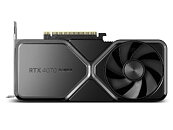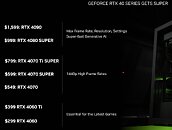- Joined
- Oct 9, 2007
- Messages
- 47,294 (7.52/day)
- Location
- Hyderabad, India
| System Name | RBMK-1000 |
|---|---|
| Processor | AMD Ryzen 7 5700G |
| Motherboard | ASUS ROG Strix B450-E Gaming |
| Cooling | DeepCool Gammax L240 V2 |
| Memory | 2x 8GB G.Skill Sniper X |
| Video Card(s) | Palit GeForce RTX 2080 SUPER GameRock |
| Storage | Western Digital Black NVMe 512GB |
| Display(s) | BenQ 1440p 60 Hz 27-inch |
| Case | Corsair Carbide 100R |
| Audio Device(s) | ASUS SupremeFX S1220A |
| Power Supply | Cooler Master MWE Gold 650W |
| Mouse | ASUS ROG Strix Impact |
| Keyboard | Gamdias Hermes E2 |
| Software | Windows 11 Pro |
NVIDIA today gave its GeForce RTX 40-series "Ada" a midlife refresh targeting the higher end of its product stack, with the new GeForce RTX 4070 SUPER, GeForce RTX 4070 Ti SUPER, and the GeForce RTX 4080 SUPER. The new RTX 4080 SUPER replaces the current RTX 4080, which will gradually be phased out of the market. The new RTX 4070 Ti SUPER does the same to the current RTX 4070 Ti. The RTX 4070 SUPER, however, will coexist with the current RTX 4070, albeit at a slight price premium. The RTX 4070 SUPER and RTX 4070 Ti SUPER are both being recommended by NVIDIA for maxed out 1440p gaming with full ray tracing; while the RTX 4080 SUPER is for those who want to max out gameplay at 4K with full ray tracing. The RTX 4070 SUPER and RTX 4070 Ti SUPER should still very much be capable of 4K gaming and more than acceptable frame rates, especially given the latest DLSS 3 Frame Generation and its proliferation among new AAA titles.
NVIDIA is giving the three new graphics card SKUs a staggered launch spread across January 2024. The RTX 4070 SUPER should be available to purchase on January 17, at a starting price of $599, which was the original MSRP of the RTX 4070. After this launch, the RTX 4070 slides down a bit to $549 while remaining in the product stack. Things get interesting higher up the stack. The RTX 4070 Ti SUPER, which goes on sale on January 24, is priced at $799, while the current RTX 4070 Ti is being retired from the product stack. The remaining RTX 4070 Ti cards should be up at slightly discounted prices.





The new RTX 4080 SUPER is the most interesting card among the three in terms of pricing. When it goes on sale, on January 31, it will be priced at $999, which is $200 lower than the launch price of the original RTX 4080. As with all product launches in the series so far, NVIDIA is encouraging its custom board partners to have products at the MSRP, by giving them a day early review publication date (which should get them to innovate with their most affordable products).
The new GeForce RTX 4070 SUPER is carved out of the same 5 nm "AD104" silicon as the RTX 4070 and RTX 4070 Ti. The "AD104" physically has 60 SM (streaming multiprocessors), from which the original RTX 4070 only got 46, and the RTX 4070 Ti maxed out all 60. The new RTX 4070 SUPER being launched today gets 56 SM, which gives it 7,168 CUDA cores, 224 Tensor cores, 56 RT cores, 224 TMUs, and the full 80 ROPs present on the silicon (the RTX 4070 only got 64). The memory sub-system is unchanged from the RTX 4070—12 GB of 21 Gbps GDDR6X memory across a 192-bit memory bus.




Given that NVIDIA maxed out the "AD104" to create the RTX 4070 Ti, it turned to the larger "AD103" silicon to come up with the RTX 4070 Ti SUPER, which in our opinion gets the biggest specs upgrade in this refresh. The RTX 4070 Ti SUPER comes with 16 GB of 21 Gbps GDDR6X memory, across the wider 256-bit memory bus of the "AD103." The SM count has increased by 10%, now at 66 out of the 80 present on the "AD103." This gives it 8,448 CUDA cores, 264 Tensor cores, 66 RT cores, 264 TMUs, and a 112 ROPs. The 21 Gbps GDDR6X memory across 256-bit memory bus yields a healthy 716 GB/s of memory bandwidth.
Lastly, there's the GeForce RTX 4080 SUPER. NVIDIA had nearly maxed out the "AD103" to create the original RTX 4080, but resisted the temptation to use the larger "AD102" for the RTX 4080 SUPER. It think it has what it needs to carve out a faster product within the "AD103." The RTX 4080 SUPER maxes out the silicon, enabling all 80 SM, for 10,240 CUDA cores, 320 Tensor cores, 80 RT cores, 320 TMUs, and 112 ROPs. While the original RTX 4080 had a memory speed of 22.4 Gbps, NVIDIA has increased this to 23 Gbps on the RTX 4080 SUPER, giving it 736 GB/s of bandwidth.
The GPU base and boost frequencies are almost the same between the RTX 4070 and RTX 4070 SUPER; as well as that between the RTX 4070 Ti and RTX 4070 Ti SUPER; but sees a 100 MHz increase on both values, between the RTX 4080 and RTX 4080 SUPER.

In terms of TGP (total graphics power), the RTX 4070 SUPER gets a 10% increase to 220 W, which means that you no longer have custom-design boards with single 8-pin PCIe power connectors, they all have 12VHPWR, and include an NVIDIA-designed adapter that converts two 8-pin PCIe to a 12VHPWR capable of delivering 300 W continuous. The TGP of the RTX 4070 Ti SUPER remains at 285 W; as does that of the RTX 4080 SUPER, at 320 W.
View at TechPowerUp Main Site
NVIDIA is giving the three new graphics card SKUs a staggered launch spread across January 2024. The RTX 4070 SUPER should be available to purchase on January 17, at a starting price of $599, which was the original MSRP of the RTX 4070. After this launch, the RTX 4070 slides down a bit to $549 while remaining in the product stack. Things get interesting higher up the stack. The RTX 4070 Ti SUPER, which goes on sale on January 24, is priced at $799, while the current RTX 4070 Ti is being retired from the product stack. The remaining RTX 4070 Ti cards should be up at slightly discounted prices.





The new RTX 4080 SUPER is the most interesting card among the three in terms of pricing. When it goes on sale, on January 31, it will be priced at $999, which is $200 lower than the launch price of the original RTX 4080. As with all product launches in the series so far, NVIDIA is encouraging its custom board partners to have products at the MSRP, by giving them a day early review publication date (which should get them to innovate with their most affordable products).
The new GeForce RTX 4070 SUPER is carved out of the same 5 nm "AD104" silicon as the RTX 4070 and RTX 4070 Ti. The "AD104" physically has 60 SM (streaming multiprocessors), from which the original RTX 4070 only got 46, and the RTX 4070 Ti maxed out all 60. The new RTX 4070 SUPER being launched today gets 56 SM, which gives it 7,168 CUDA cores, 224 Tensor cores, 56 RT cores, 224 TMUs, and the full 80 ROPs present on the silicon (the RTX 4070 only got 64). The memory sub-system is unchanged from the RTX 4070—12 GB of 21 Gbps GDDR6X memory across a 192-bit memory bus.




Given that NVIDIA maxed out the "AD104" to create the RTX 4070 Ti, it turned to the larger "AD103" silicon to come up with the RTX 4070 Ti SUPER, which in our opinion gets the biggest specs upgrade in this refresh. The RTX 4070 Ti SUPER comes with 16 GB of 21 Gbps GDDR6X memory, across the wider 256-bit memory bus of the "AD103." The SM count has increased by 10%, now at 66 out of the 80 present on the "AD103." This gives it 8,448 CUDA cores, 264 Tensor cores, 66 RT cores, 264 TMUs, and a 112 ROPs. The 21 Gbps GDDR6X memory across 256-bit memory bus yields a healthy 716 GB/s of memory bandwidth.
Lastly, there's the GeForce RTX 4080 SUPER. NVIDIA had nearly maxed out the "AD103" to create the original RTX 4080, but resisted the temptation to use the larger "AD102" for the RTX 4080 SUPER. It think it has what it needs to carve out a faster product within the "AD103." The RTX 4080 SUPER maxes out the silicon, enabling all 80 SM, for 10,240 CUDA cores, 320 Tensor cores, 80 RT cores, 320 TMUs, and 112 ROPs. While the original RTX 4080 had a memory speed of 22.4 Gbps, NVIDIA has increased this to 23 Gbps on the RTX 4080 SUPER, giving it 736 GB/s of bandwidth.
The GPU base and boost frequencies are almost the same between the RTX 4070 and RTX 4070 SUPER; as well as that between the RTX 4070 Ti and RTX 4070 Ti SUPER; but sees a 100 MHz increase on both values, between the RTX 4080 and RTX 4080 SUPER.

In terms of TGP (total graphics power), the RTX 4070 SUPER gets a 10% increase to 220 W, which means that you no longer have custom-design boards with single 8-pin PCIe power connectors, they all have 12VHPWR, and include an NVIDIA-designed adapter that converts two 8-pin PCIe to a 12VHPWR capable of delivering 300 W continuous. The TGP of the RTX 4070 Ti SUPER remains at 285 W; as does that of the RTX 4080 SUPER, at 320 W.
View at TechPowerUp Main Site






